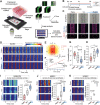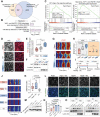Mechanobiological Adaptation to Hyperosmolarity Enhances Barrier Function in Human Vascular Microphysiological System
- PMID: 36808839
- PMCID: PMC10161024
- DOI: 10.1002/advs.202206384
Mechanobiological Adaptation to Hyperosmolarity Enhances Barrier Function in Human Vascular Microphysiological System
Abstract
In infectious disease such as sepsis and COVID-19, blood vessel leakage treatment is critical to prevent fatal progression into multi-organ failure and ultimately death, but the existing effective therapeutic modalities that improve vascular barrier function are limited. Here, this study reports that osmolarity modulation can significantly improve vascular barrier function, even in an inflammatory condition. 3D human vascular microphysiological systems and automated permeability quantification processes for high-throughput analysis of vascular barrier function are utilized. Vascular barrier function is enhanced by >7-folds with 24-48 h hyperosmotic exposure (time window of emergency care; >500 mOsm L-1 ) but is disrupted after hypo-osmotic exposure (<200 mOsm L-1 ). By integrating genetic and protein level analysis, it is shown that hyperosmolarity upregulates vascular endothelial-cadherin, cortical F-actin, and cell-cell junction tension, indicating that hyperosmotic adaptation mechanically stabilizes the vascular barrier. Importantly, improved vascular barrier function following hyperosmotic exposure is maintained even after chronic exposure to proinflammatory cytokines and iso-osmotic recovery via Yes-associated protein signaling pathways. This study suggests that osmolarity modulation may be a unique therapeutic strategy to proactively prevent infectious disease progression into severe stages via vascular barrier function protection.
Keywords: 3D human vascular microphysiological system; Yes-associated protein (YAP); hyperosmolarity; inflammation; mechanobiology; vascular barrier function.
© 2023 The Authors. Advanced Science published by Wiley-VCH GmbH.
Conflict of interest statement
The authors declare no conflict of interest.
Figures






Similar articles
-
Short-time exposure of hyperosmolarity triggers interleukin-6 expression in corneal epithelial cells.Cornea. 2014 Dec;33(12):1342-7. doi: 10.1097/ICO.0000000000000256. Cornea. 2014. PMID: 25255138
-
IL-36α/IL-36RA/IL-38 signaling mediates inflammation and barrier disruption in human corneal epithelial cells under hyperosmotic stress.Ocul Surf. 2021 Oct;22:163-171. doi: 10.1016/j.jtos.2021.08.012. Epub 2021 Aug 21. Ocul Surf. 2021. PMID: 34428579 Free PMC article.
-
Effects of L-carnitine, erythritol and betaine on pro-inflammatory markers in primary human corneal epithelial cells exposed to hyperosmotic stress.Curr Eye Res. 2015 Jul;40(7):657-67. doi: 10.3109/02713683.2014.957776. Epub 2014 Oct 1. Curr Eye Res. 2015. PMID: 25271595 Free PMC article.
-
Rap1 Small GTPase Regulates Vascular Endothelial-Cadherin-Mediated Endothelial Cell-Cell Junctions and Vascular Permeability.Biol Pharm Bull. 2021;44(10):1371-1379. doi: 10.1248/bpb.b21-00504. Biol Pharm Bull. 2021. PMID: 34602545 Review.
-
Conversation before crossing: dissecting metastatic tumor-vascular interactions in microphysiological systems.Am J Physiol Cell Physiol. 2022 Nov 1;323(5):C1333-C1344. doi: 10.1152/ajpcell.00173.2022. Epub 2022 Sep 19. Am J Physiol Cell Physiol. 2022. PMID: 36121131 Free PMC article. Review.
Cited by
-
Bacterial-host adhesion dominated by collagen subtypes remodelled by osmotic pressure.NPJ Biofilms Microbiomes. 2024 Nov 12;10(1):124. doi: 10.1038/s41522-024-00600-x. NPJ Biofilms Microbiomes. 2024. PMID: 39532878 Free PMC article.
-
Using Histologic Image Analysis to Understand Biophysical Regulations of Epithelial Cell Morphology.Biophysicist (Rockv). 2024;5(1):1-14. doi: 10.35459/tbp.2023.000253. Epub 2023 Dec 7. Biophysicist (Rockv). 2024. PMID: 39165674 Free PMC article.
-
Hypertonic treatment of acute respiratory distress syndrome.Front Bioeng Biotechnol. 2023 Oct 23;11:1250312. doi: 10.3389/fbioe.2023.1250312. eCollection 2023. Front Bioeng Biotechnol. 2023. PMID: 37936822 Free PMC article.
References
-
- Aird W. C., Blood 2003, 101, 3765. - PubMed
-
- a) Xiao F., Wang D., Kong L., Li M., Feng Z., Shuai B., Wang L., Wei Y., Li H., Wu S., Tan C., Zhao H., Hu X., Liu J., Kang Y., Liao X., Zhou Y., Zhang W., Nat. Commun. 2018, 9, 2644; - PMC - PubMed
- b) Fink M. P., Warren H. S., Nat. Rev. Drug Discovery 2014, 13, 741; - PubMed
- c) Han S., Lee S. J., Kim K. E., Lee H. S., Oh N., Park I., Ko E., Oh S. J., Lee Y. S., Kim D., Lee S., Lee D. H., Lee K. H., Chae S. Y., Lee J. H., Kim S. J., Kim H. C., Kim S., Kim S. H., Kim C., Nakaoka Y., He Y., Augustin H. G., Hu J., Song P. H., Kim Y. I., Kim P., Kim I., Koh G. Y., Sci. Transl. Med. 2016, 8, 335ra55. - PubMed
Publication types
MeSH terms
Substances
Grants and funding
LinkOut - more resources
Full Text Sources
Medical
